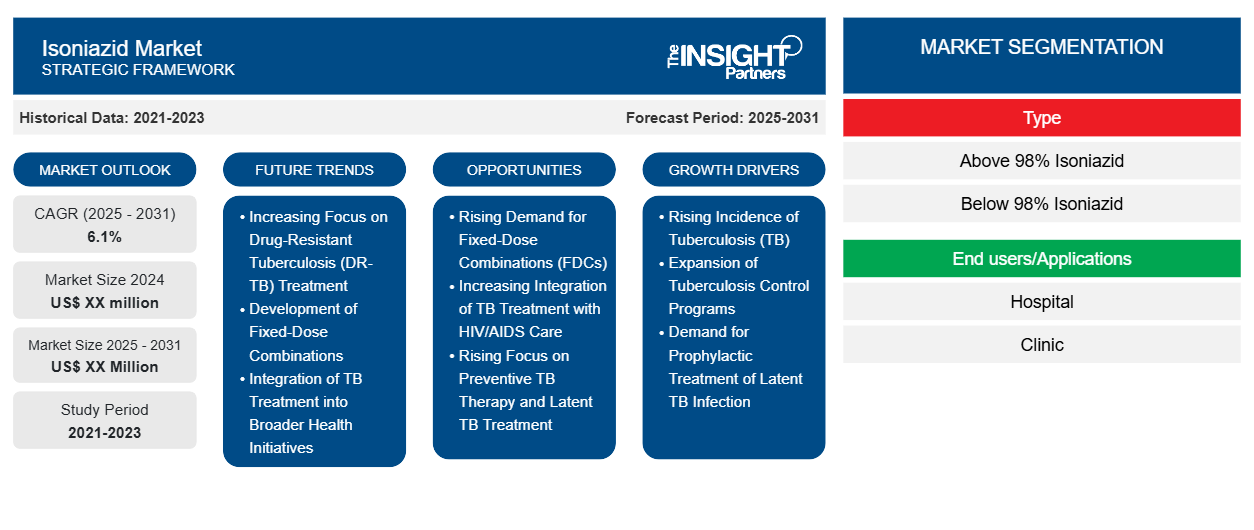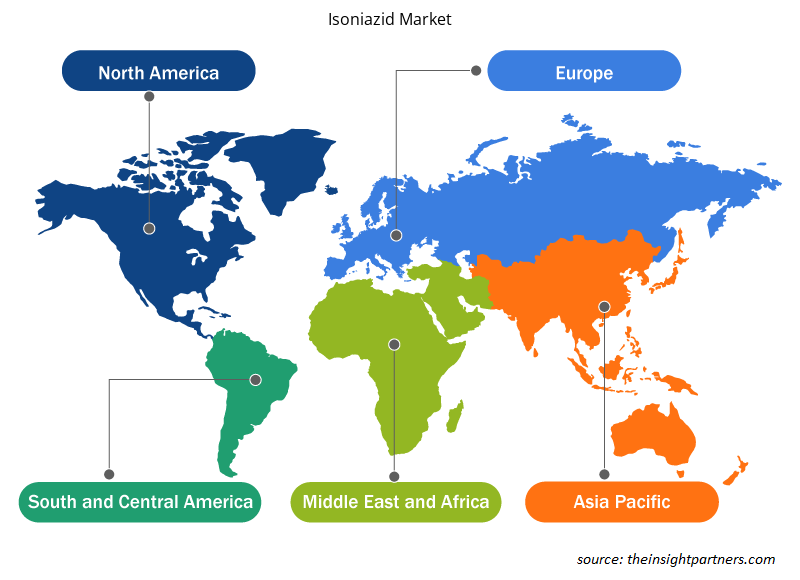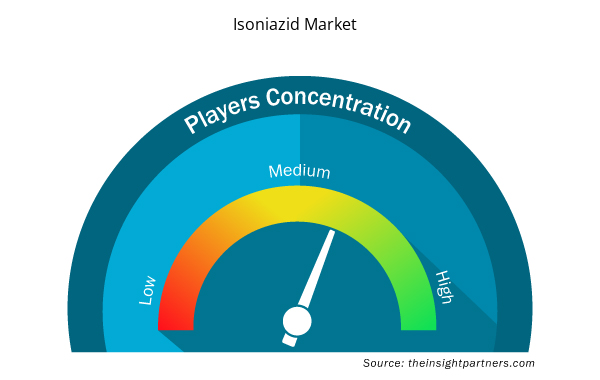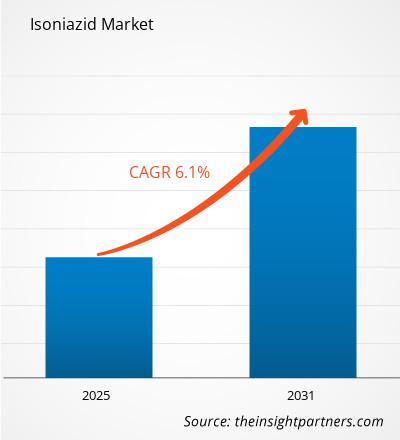The Isoniazid Market is expected to register a CAGR of 6.1% from 2025 to 2031, with a market size expanding from US$ XX million in 2024 to US$ XX Million by 2031.
The report is segmented by Type (Above 98% Isoniazid, Below 98% Isoniazid); and End users/Applications (Hospital, Clinic, Others). The global analysis is broken down at the regional level and for major countries. The market evaluation is presented in US$ for the above segmental analysis.
Purpose of the Report
The report Isoniazid Market by The Insight Partners aims to describe the present landscape and future growth, top driving factors, challenges, and opportunities. This will provide insights to various business stakeholders, such as:
- Technology Providers/Manufacturers: To understand the evolving market dynamics and know the potential growth opportunities, enabling them to make informed strategic decisions.
- Investors: To conduct a comprehensive trend analysis regarding the market growth rate, market financial projections, and opportunities that exist across the value chain.
- Regulatory bodies: To regulate policies and police activities in the market with the aim of minimizing abuse, preserving investor trust and confidence, and upholding the integrity and stability of the market.
Isoniazid Market Segmentation
Type
- Above 98% Isoniazid
- Below 98% Isoniazid
End users/Applications
- Hospital
- Clinic
Customize This Report To Suit Your Requirement
You will get customization on any report - free of charge - including parts of this report, or country-level analysis, Excel Data pack, as well as avail great offers and discounts for start-ups & universities
Isoniazid Market: Strategic Insights

- Get Top Key Market Trends of this report.This FREE sample will include data analysis, ranging from market trends to estimates and forecasts.
Isoniazid Market Growth Drivers
- Rising Incidence of Tuberculosis (TB): The increasing incidence of tuberculosis (TB) worldwide remains the primary growth driver for the Isoniazid market. Tuberculosis cases keep rising worldwide which makes up the main reason for Isoniazid market growth. Tuberculosis affects many people worldwide, especially in poor nations. The World Health Organization indicates that TB ranks among the ten leading causes of death worldwide with millions of new patients developing the condition every year. Isoniazid stands as the foundational medication in TB treatment programs along with its use for preventing disease in high-risk groups. The number of TB cases growing mainly in Southeast Asia, Africa, and Eastern Europe means that more effective TB treatments like Isoniazid will be needed in the future. The need for effective TB drugs like Isoniazid grows stronger due to rising cases of drug-resistant TB especially MDR-TB and XDR-TB which makes treatment more crucial than ever. For TB control programs to succeed at early treatment they need Isoniazid as their essential drug. The market will grow because TB spreads more and healthcare efforts worldwide increase to fight this disease. Market projections show Isoniazid will grow in demand as TB treatment methods improve because it remains an important part of combination therapy regimens and works well against the disease.
- Expansion of Tuberculosis Control Programs: Government and international organization programs to fight tuberculosis represent the main market drivers for Isoniazid. Through initiatives like the End TB Strategy the WHO and national health authorities expand their efforts to make TB diagnosis and treatment available to all. Healthcare providers depend on Isoniazid as a first-line treatment and prevention tool during TB control programs. Through TB control programs in developing nations, Isoniazid becomes more available at low or no cost as part of disease treatment efforts. The increased focus on TB care during the COVID-19 pandemic led to greater efforts to detect and treat the disease which pushed resources toward these activities. The market grows because TB control programs expand their services across India, China, and South Africa. The programs work to manage TB fully by including Isoniazid treatment in both TB treatment and population protection strategies. Forecasts suggest that as TB control initiatives continue to expand and improve, the demand for Isoniazid will grow, particularly in regions with high TB incidence, thus driving the overall market size and market share of the drug.
- Demand for Prophylactic Treatment of Latent TB Infection: The market for Isoniazid grows because health experts now prioritize treating latent tuberculosis infections to prevent the disease from becoming active. Latent TB presents the greatest danger of turning into active TB for people with weak immune systems especially HIV patients says the CDC. Under global health prevention programs Isoniazid acts as prophylaxis to decrease the chances of latent TB patients developing active disease. Doctors prescribe Isoniazid often because it remains an effective and trusted medicine for treating LTBI. Many countries with high TB cases use Isoniazid-based therapy as their main defense in TB control because it protects people who live with active TB patients or have weakened immune systems. The increasing effort to prevent TB from reactivating in at-risk groups will boost Isoniazid sales globally. The market for Isoniazid as TB prevention treatment will expand because future predictions show that health initiatives against TB will need more Isoniazid to protect people from this disease.
Isoniazid Market Future Trends
- Increasing Focus on Drug-Resistant Tuberculosis (DR-TB) Treatment: One of the key trends influencing the Isoniazid market is the increasing focus on drug-resistant tuberculosis (DR-TB), including multidrug-resistant TB (MDR-TB) and extensively drug-resistant TB (XDR-TB). With the rise in drug-resistant strains of Mycobacterium tuberculosis, there is growing concern about the effectiveness of traditional first-line therapies. While Isoniazid remains a core component of TB treatment regimens, its use in combination with second-line drugs is becoming more common in the treatment of resistant strains. The increased prevalence of MDR-TB has led to the development of novel treatment strategies that include Isoniazid as part of combination therapy to overcome drug resistance. This trend is expected to boost the demand for Isoniazid, as it is a cost-effective and essential component in managing both drug-sensitive and drug-resistant TB. Market forecasts suggest that the rising global incidence of MDR-TB and the increasing need for combination therapies will drive the continued use and demand for Isoniazid in global TB treatment programs. Pharmaceutical companies are also exploring ways to enhance Isoniazid’s efficacy and safety when used alongside other TB drugs to address the growing challenge of drug resistance. The focus on DR-TB treatment will ensure that Isoniazid remains a key player in the market.
- Development of Fixed-Dose Combinations: A notable trend in the Isoniazid market is the development of fixed-dose combinations (FDCs) of TB drugs. Fixed-dose combinations are increasingly being utilized in TB treatment regimens to improve patient adherence and simplify the treatment process. Isoniazid is often combined with other first-line TB drugs, such as Rifampicin, Pyrazinamide, and Ethambutol, into FDC formulations that are easier for patients to take. These combinations help to improve treatment adherence by reducing the pill burden, which is a common issue in TB treatment. The growing demand for FDCs is expected to drive the market for Isoniazid, as these combination therapies are more convenient and have shown positive results in reducing the global TB burden. As part of global efforts to simplify TB treatment and improve treatment adherence, FDCs are gaining popularity, particularly in resource-limited settings where TB prevalence is high. Market forecasts predict that the increasing development and adoption of FDCs will enhance the growth prospects for Isoniazid, positioning it as a key component in modern TB treatment strategies. This trend will contribute to the expansion of the Isoniazid market, particularly in high-burden countries where treatment adherence is critical to combating TB.
- Integration of TB Treatment into Broader Health Initiatives: Another emerging trend in the Isoniazid market is the integration of tuberculosis treatment into broader global health initiatives, particularly those aimed at addressing HIV/AIDS. TB and HIV co-infection is a significant issue, especially in sub-Saharan Africa, where both diseases are prevalent. Isoniazid plays a critical role in the treatment and prevention of TB in HIV-positive patients, who are more susceptible to developing active TB. As global health organizations focus on the dual burden of HIV and TB, the demand for Isoniazid as part of combined TB/HIV treatment programs is expected to rise. The integration of TB treatment into broader health initiatives, such as the Global Fund’s programs, is helping to increase access to TB drugs like Isoniazid in areas with high rates of co-infection. This trend is expected to drive the market for Isoniazid as part of comprehensive treatment regimens aimed at reducing the global burden of both diseases. Market forecasts suggest that the increasing integration of TB treatment into global health strategies will further support the growth of the Isoniazid market, especially in regions most affected by the TB and HIV co-epidemic.
Isoniazid Market Opportunities
- Rising Demand for Fixed-Dose Combinations (FDCs): The Isoniazid market has an important growth option from rising need for TB drug combination pills. The fixed-dose combination (FDC) pills of TB first-line drugs including Isoniazid simplify patient treatment by providing all necessary medications in a single dosage. TB patients struggle to follow their entire treatment because they must take many pills every day for several days. When patients take FDCs they follow their treatment better and lower the chances of drug resistance while getting better results from their therapy. The demand for Isoniazid with Rifampicin, Pyrazinamide, and Ethambutol combination pills will increase as more TB control programs worldwide switch to First-Line Drug Combinations. Healthcare systems with limited resources need better patient treatment adherence to stop TB from spreading. The Isoniazid market will expand due to growing acceptance of FDC (Fixed-Dose Combination) therapy worldwide as countries embrace patient-friendly treatment methods. Companies that make Isoniazid-based combination drugs will take a larger market share as more pharmaceutical companies adopt FDC formulations. New Isoniazid-based combination medications will help the global TB treatment system grow better and more effective.
- Increasing Integration of TB Treatment with HIV/AIDS Care: The connection between tuberculosis treatment and HIV/AIDS care opens new market possibilities for Isoniazid. TB patients with HIV make up a large part of public health concerns in sub-Saharan Africa's communities. People with HIV have a higher chance of getting TB and TB kills more people with HIV than any other condition. Isoniazid helps protect HIV-positive patients from developing TB because healthcare providers use it to manage both active TB cases and latent TB infections in this population. The WHO UNAIDS and national health ministries lead global efforts which improve the availability of TB treatment for people living with HIV. These plans combine TB services directly with services for people living with HIV/AIDS. Integrated HIV and TB care strategies across the world will need more Isoniazid to maintain effective treatment programs. The need for Isoniazid treatment by pharmaceutical companies will increase because patients with both TB and HIV will need it as part of their integrated care. Pharmaceutical companies that specialize in delivering Isoniazid therapies to the HIV-positive population will take over more of the market when TB and HIV infections overlap most heavily. By combining TB and HIV treatments the market for Isoniazid will grow bigger and attract more customers.
- Rising Focus on Preventive TB Therapy and Latent TB Treatment: The Isoniazid market holds significant growth prospects from increased efforts to treat latent tuberculosis infection (LTBI). The healthcare system faces a major public health issue in controlling LTBI among people who are at risk especially patients with HIV, medical staff and those living in close quarters. When LTBI stays untreated it can advance to active tuberculosis which strains healthcare systems globally. The sales of Isoniazid therapy will expand because patients need it more to stop LTBI from developing into active TB. High-burden countries with many people at risk benefit most from TB prevention therapy since it stops spread of the disease. Global health bodies like WHO will promote LTBI screening more which means businesses will see rising demand for Isoniazid. Pharmaceutical companies need to make Isoniazid more affordable and easier to obtain so LTBI prevention programs can reach more people. The Isoniazid market growth potential targets areas with heavy tuberculosis cases and vulnerable groups. The worldwide fight against tuberculosis needs more use of Isoniazid because treating latent TB early will make active tuberculosis cases fewer.
Isoniazid Market Regional Insights
The regional trends and factors influencing the Isoniazid Market throughout the forecast period have been thoroughly explained by the analysts at Insight Partners. This section also discusses Isoniazid Market segments and geography across North America, Europe, Asia Pacific, Middle East and Africa, and South and Central America.

- Get the Regional Specific Data for Isoniazid Market
Isoniazid Market Report Scope
| Report Attribute | Details |
|---|---|
| Market size in 2024 | US$ XX million |
| Market Size by 2031 | US$ XX Million |
| Global CAGR (2025 - 2031) | 6.1% |
| Historical Data | 2021-2023 |
| Forecast period | 2025-2031 |
| Segments Covered |
By Type
|
| Regions and Countries Covered | North America
|
| Market leaders and key company profiles |
Isoniazid Market Players Density: Understanding Its Impact on Business Dynamics
The Isoniazid Market market is growing rapidly, driven by increasing end-user demand due to factors such as evolving consumer preferences, technological advancements, and greater awareness of the product's benefits. As demand rises, businesses are expanding their offerings, innovating to meet consumer needs, and capitalizing on emerging trends, which further fuels market growth.
Market players density refers to the distribution of firms or companies operating within a particular market or industry. It indicates how many competitors (market players) are present in a given market space relative to its size or total market value.
Major Companies operating in the Isoniazid Market are:
- AMSAL CHEM,
- Resonance Specialties
- Calyx Pharma and Chem
- Camus pharma,
- Titan Pharma (India)
- Taizhou Tianrui Pharmaceutical
Disclaimer: The companies listed above are not ranked in any particular order.

- Get the Isoniazid Market top key players overview
Key Selling Points
- Comprehensive Coverage: The report comprehensively covers the analysis of products, services, types, and end users of the Isoniazid Market, providing a holistic landscape.
- Expert Analysis: The report is compiled based on the in-depth understanding of industry experts and analysts.
- Up-to-date Information: The report assures business relevance due to its coverage of recent information and data trends.
- Customization Options: This report can be customized to cater to specific client requirements and suit the business strategies aptly.
The research report on the Isoniazid Market can, therefore, help spearhead the trail of decoding and understanding the industry scenario and growth prospects. Although there can be a few valid concerns, the overall benefits of this report tend to outweigh the disadvantages.
- Historical Analysis (2 Years), Base Year, Forecast (7 Years) with CAGR
- PEST and SWOT Analysis
- Market Size Value / Volume - Global, Regional, Country
- Industry and Competitive Landscape
- Excel Dataset



Report Coverage
Revenue forecast, Company Analysis, Industry landscape, Growth factors, and Trends

Segment Covered
This text is related
to segments covered.

Regional Scope
North America, Europe, Asia Pacific, Middle East & Africa, South & Central America

Country Scope
This text is related
to country scope.
Frequently Asked Questions
The Isoniazid Market is estimated to witness a CAGR of 6.1% from 2025 to 2031.
The major factors driving the Isoniazid Market are Rising Incidence of Tuberculosis (TB), Expansion of Tuberculosis Control Programs, and Demand for Prophylactic Treatment of Latent TB Infection.
Future trends in the Isoniazid Market are Increasing Focus on Drug-Resistant Tuberculosis (DR-TB) Treatment, Development of Fixed-Dose Combinations, and Integration of TB Treatment into Broader Health Initiatives.
Some of the players operating in the market are AMSAL CHEM, Resonance Specialties, Calyx Pharma and Chem, Camus Pharma, Titan Pharma (India), Taizhou Tianrui Pharmaceutical, Zhejiang Second Pharma.
The report can be delivered in PDF/PPT format; we can also share an excel datasheet based on the request.
Some customization options available based on the request are an additional 3–5 company profiles and a country-specific analysis of 3–5 countries of your choice. Customizations are to be requested/discussed before making final order confirmation# as our team would review the same and check the feasibility.
Trends and growth analysis reports related to Life Sciences : READ MORE..
1. AMSAL CHEM
2. Resonance Specialties
3. Calyx Pharma and Chem
4. Camus pharma
5. Titan Pharma (India)
6. Taizhou Tianrui Pharmaceutical
7. Zhejiang Second Pharma

 Get Free Sample For
Get Free Sample For